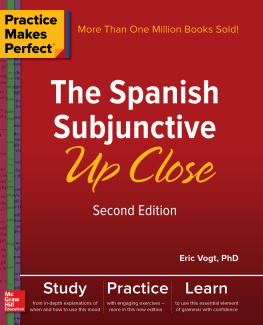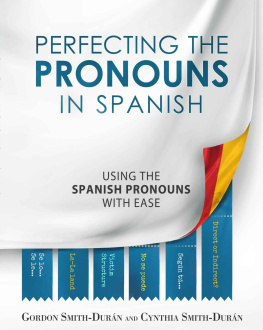Eric Vogt - Spanish Pronouns Up Close
Here you can read online Eric Vogt - Spanish Pronouns Up Close full text of the book (entire story) in english for free. Download pdf and epub, get meaning, cover and reviews about this ebook. year: 2008, publisher: McGraw-Hill Companies, genre: Home and family. Description of the work, (preface) as well as reviews are available. Best literature library LitArk.com created for fans of good reading and offers a wide selection of genres:
Romance novel
Science fiction
Adventure
Detective
Science
History
Home and family
Prose
Art
Politics
Computer
Non-fiction
Religion
Business
Children
Humor
Choose a favorite category and find really read worthwhile books. Enjoy immersion in the world of imagination, feel the emotions of the characters or learn something new for yourself, make an fascinating discovery.

- Book:Spanish Pronouns Up Close
- Author:
- Publisher:McGraw-Hill Companies
- Genre:
- Year:2008
- Rating:4 / 5
- Favourites:Add to favourites
- Your mark:
- 80
- 1
- 2
- 3
- 4
- 5
Spanish Pronouns Up Close: summary, description and annotation
We offer to read an annotation, description, summary or preface (depends on what the author of the book "Spanish Pronouns Up Close" wrote himself). If you haven't found the necessary information about the book — write in the comments, we will try to find it.
Spanish Pronouns Up Close — read online for free the complete book (whole text) full work
Below is the text of the book, divided by pages. System saving the place of the last page read, allows you to conveniently read the book "Spanish Pronouns Up Close" online for free, without having to search again every time where you left off. Put a bookmark, and you can go to the page where you finished reading at any time.
Font size:
Interval:
Bookmark:

 Copyright 2008 by The McGraw-Hill Companies, Inc. All rights reserved. Except as permitted under the United States Copyright Act of 1976, no part of this publication may be reproduced or distributed in any form or by any means, or stored in a database or retrieval system, without the prior written permission of the publisher. ISBN: 978-0-07-177173-3
Copyright 2008 by The McGraw-Hill Companies, Inc. All rights reserved. Except as permitted under the United States Copyright Act of 1976, no part of this publication may be reproduced or distributed in any form or by any means, or stored in a database or retrieval system, without the prior written permission of the publisher. ISBN: 978-0-07-177173-3
MHID: 0-07-177173-5 The material in this eBook also appears in the print version of this title: ISBN: 978-0-07-149224-9, MHID: 0-07-149224-0. All trademarks are trademarks of their respective owners. Rather than put a trademark symbol after every occurrence of a trademarked name, we use names in an editorial fashion only, and to the benefit of the trademark owner, with no intention of infringement of the trademark.
Where such designations appear in this book, they have been printed with initial caps. McGraw-Hill eBooks are available at special quantity discounts to use as premiums and sales promotions, or for use in corporate training programs. To contact a representative please e-mail us at bulksales@mcgraw-hill.com. Interior design by Village Typographers, Inc. TERMS OF USE This is a copyrighted work and The McGraw-Hill Companies, Inc. (McGraw-Hill) and its licensors reserve all rights in and to the work.
Use of this work is subject to these terms. Except as permitted under the Copyright Act of 1976 and the right to store and retrieve one copy of the work, you may not decompile, disassemble, reverse engineer, reproduce, modify, create derivative works based upon, transmit, distribute, disseminate, sell, publish or sublicense the work or any part of it without McGraw-Hills prior consent. You may use the work for your own noncommercial and personal use; any other use of the work is strictly prohibited. Your right to use the work may be terminated if you fail to comply with these terms. THE WORK IS PROVIDED AS IS. McGRAW-HILL AND ITS LICENSORS MAKE NO GUARANTEES OR WARRANTIES AS TO THE ACCURACY, ADEQUACY OR COMPLETENESS OF OR RESULTS TO BE OBTAINED FROM USING THE WORK, INCLUDING ANY INFORMATION THAT CAN BE ACCESSED THROUGH THE WORK VIA HYPERLINK OR OTHERWISE, AND EXPRESSLY DISCLAIM ANY WARRANTY, EXPRESS OR IMPLIED, INCLUDING BUT NOT LIMITED TO IMPLIED WARRANTIES OF MERCHANTABILITY OR FITNESS FOR A PARTICULAR PURPOSE.
McGraw-Hill and its licensors do not warrant or guarantee that the functions contained in the work will meet your requirements or that its operation will be uninterrupted or error free. Neither McGraw-Hill nor its licensors shall be liable to you or anyone else for any inaccuracy, error or omission, regardless of cause, in the work or for any damages resulting therefrom. McGraw-Hill has no responsibility for the content of any information accessed through the work. Under no circumstances shall McGraw-Hill and/or its licensors be liable for any indirect, incidental, special, punitive, consequential or similar damages that result from the use of or inability to use the work, even if any of them has been advised of the possibility of such damages. This limitation of liability shall apply to any claim or cause whatsoever whether such claim or cause arises in contract, tort or otherwise.
Likewise to Susan Moore for her diligence and sharp eye. As ever, I thank Lylje Klein for noticing every point that needed clarifying. I also thank my students who, during the 20072008 year, used earlier versions of these chapters and commented on their usefulness. No amount of thanks will ever be enough to tell my family how much Ive missed them while theyve waited for me on Bainbridge Island as Ive worked late nights in Seattle on this and other projects over the past two years.
Pronouns, one of the parts of speech along with articles, verbs, nouns, adjectives, and so on, consist of a small number of little words with big jobs to do. They tell you who is doing something or who is giving what to whom, together with a host of other functions that we examine in this book. Pronouns are words that stand in for a noun. Nouns, you may recall, are names of people, places, things, or feelings (John, Susan, Chicago, table, bird, flower, love, anger,). He (l) is used instead of John, if John is the subject and the speaker and listener already have mentioned John by name. If John is the object, him (lo) stands in for John.
Although it is not always the case, in both English and Spanish the form of a pronoun often indicates its grammatical function:  Lets indulge in a grammatical analogy using baseball to introduce you to the communicative richness of this small group of words known as pronouns. First, we will learn the names of three of the main types of pronouns and discover what their roles are on the language-learning playing field. (Of course, if the influences in your life happen to be British, you might have to make some quick mental adjustments to adapt the names of the positions on the field to cricket, but we Yanks trust that you will follow along just fine.) When a person is doing something, he or she is the actorthe active agent of an action. The action itself is expressed by a verb. In baseball, the most common actions are batting, catching, and throwing. When a batter steps up to the plate, bat in hand, awaiting the pitch, he awaits an action on the part of the pitcher on the mound.
Lets indulge in a grammatical analogy using baseball to introduce you to the communicative richness of this small group of words known as pronouns. First, we will learn the names of three of the main types of pronouns and discover what their roles are on the language-learning playing field. (Of course, if the influences in your life happen to be British, you might have to make some quick mental adjustments to adapt the names of the positions on the field to cricket, but we Yanks trust that you will follow along just fine.) When a person is doing something, he or she is the actorthe active agent of an action. The action itself is expressed by a verb. In baseball, the most common actions are batting, catching, and throwing. When a batter steps up to the plate, bat in hand, awaiting the pitch, he awaits an action on the part of the pitcher on the mound.
From a grammatical point of view, at the opening of the game the pitcher is the subject when he throws the ball, because he is the one who throws it. The ball is what he throws; thus, grammatically speaking, the ball is the direct object. A direct object receives the action of a verb directly. In our analogy, the action, expressed by the verb, is the pitch. While the ball is hurling through the air at 90 miles per hour or more, the batter is waiting to become the next subjectthat is, the one who will hit the ball (or, if you happen to be a Chicago Cubs fan, the one who will strike at itand miss, of course). For a split secondthe moment the ball makes contact with the batthe batter can be seen grammatically as the indirect object, the one who receives the direct object of the ball.
However, the instant he swings the bat and hits (or strikes), he is the doer, or grammatical subject. In fact, he is the subject on the field at that moment. Everyone else is awaiting the result, as anxious fans will confirm. If he strikes, the catcher, in like manner, is the indirect object at the moment the ball contacts his glove, at which instant he becomes the subject of the verb to catch, and then, remaining the subject, he performs another action, throwing the ball back to the pitcher. Each of the three playerspitcher, batter, and catcherhas been either subject or indirect object in his own way during the quick action from first pitch, to hit or strike, to catch, and to throw the ball again. The names of those positions in fact denote the role of that player as doer (subject) of a particular action (verb).
Next pageFont size:
Interval:
Bookmark:
Similar books «Spanish Pronouns Up Close»
Look at similar books to Spanish Pronouns Up Close. We have selected literature similar in name and meaning in the hope of providing readers with more options to find new, interesting, not yet read works.
Discussion, reviews of the book Spanish Pronouns Up Close and just readers' own opinions. Leave your comments, write what you think about the work, its meaning or the main characters. Specify what exactly you liked and what you didn't like, and why you think so.




